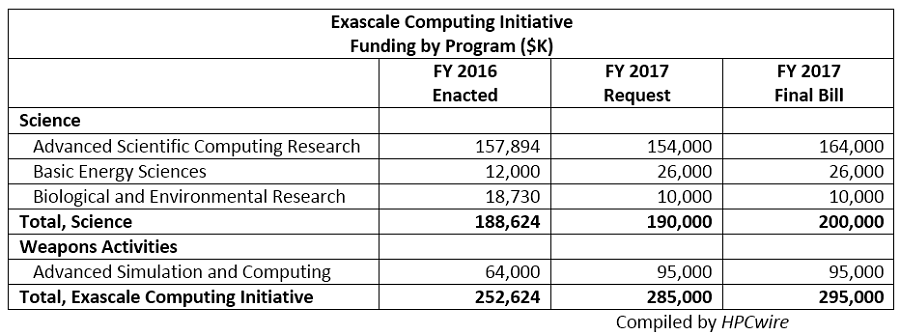Update: President Trump signed the 2017 budget bill on Friday, May 5th, averting a government shut-down. This piece looks at what it means for science and advanced compute spending.
Bipartisan congressional negotiators reached an agreement this week on the 2017 fiscal year budget, which funds the government through September 30. The bill is, as Computing Research Association Policy Analyst Brian Mosley put it, “not great, but not terrible for science.” The deal rejects most of the sweeping cuts to federal science agencies that Trump and his advisers have proposed, and some programs, notably the Department of Energy (DOE) and National Institutes of Health (NIH), will receive increases. Also up for a nice boost: the Exascale Computing Project.
Here’s a run-down:
The DOE Office of Science is set to receive a $43 million increase over FY16 levels to $5.39 billion in FY17. Advanced Scientific Computing Research (ASCR) — responsible for funding the bulk of DOE supercomputing — gets a bump from $621 million in FY16 to $647 million for FY17, an increase of 4.2 percent (but shy of President Obama’s requested 6.8 percent increase).
The Exascale Computing Project, which like so many government activities has been in the thicket of budget uncertainties, is designated to receive $259 million — that’s $10 million more than requested by the Obama administration. Of the total, $164 million falls under DOE ASCR and $95 million hits the National Nuclear Security Administration ledgers. Recall that the ECP was initiated as a joint ASCR/NNSA partnership.
As a DOE crosscut, total exascale funding, linked to the Exascale Computing Initiative, is set to go from FY16 enacted levels of $252.6 million to $295 million in FY17, an increase of nearly $42.4 million. One science official we spoke with off-record sees this appropriation as an encouraging sign from Congress.
The bill directs the DOE “to provide to the Committees on Appropriations of both Houses of Congress not later than 90 days after enactment of this Act a report that differentiates the roles and responsibilities of the NNSA and the Office of Science for carrying out the exascale computing initiative and describes how those respective roles and responsibilities are complementary and not duplicative.”
Science laboratories infrastructure will also get a boost, receiving $130 million, compared to $114 million in FY16. The new funding is marked for the Integrated Engineering Research Center at Fermi National Accelerator Laboratory and the Core Facility Revitalization project at Brookhaven National Laboratory (BNL).
The Advanced Research Projects Agency-Energy (ARPA-E) axed under the 2018 skinny budget proposal (see our coverage here), gets a robust 5.2 percent increase over FY16 enacted levels to $306 million.
The omnibus bill allots $7.46 billion for National Science Foundation (NSF) activities, a mere $9 million increase over FY16 numbers. The six research directorates and NSF’s education directorate remain at their 2016 totals ($6.033 billion and $880 million respectively). NSF did not receive the $43 million in operating funds it requested for a new headquarters building in northern Virginia.
NASA‘s budget is set at $19.65 billion, up 1.9 percent from $19.28 billion last year. Funding for earth science, slated for a 7 percent cut under Trump’s 2018 skinny budget, remains at 2016 levels: $1.92 billion.
The NIH sees the healthiest increases; the budget raises FY17 spending by $2 billion to $34.1 billion (a 6.2 percent increase). Included is $352 million already approved as part of the 21st Century Cures Act that was part of the last continuing resolution in December. The Precision Medicine Initiative is slated to receive an additional $160 million, including $40 million from the Cures act, and the BRAIN Initiative receives $120 million, including $10 million from Cures.
Hardest hit of the science agencies is the Environmental Protection Agency. It’s up for an $81 million cut, trimming roughly 1 percent from its $8.06 FY16 billion budget. But the agency avoided steeper cuts and staff reductions proposed in the skinny budget.
The $1 trillion omnibus spending bill passed the House and Senate this week with strong bipartisan support. On Wednesday, the House voted 309-118 in favor, with four members abstaining. Thursday, the bill passed in the Senate with a vote of 79-18. The President has promised to sign it.
“After years of partisan bickering and gridlock, this bill is a clear win for the American people,” Trump said Tuesday. “It’s been a very hotly contested budget because, as you know, we have to go through a long and rigorous process.”
Senate Minority Leader Chuck Schumer of N.Y. called the budget “a good agreement for the American people,” and “a win for science.”
For in-depth coverage on how the budget impacts science, refer to the Science article “How science fares in the U.S. budget deal.”




























































